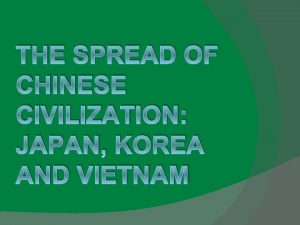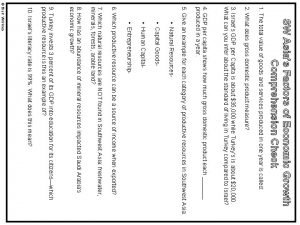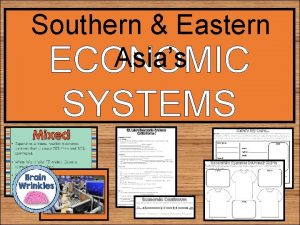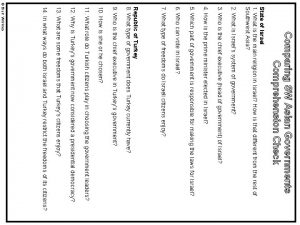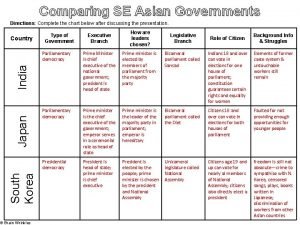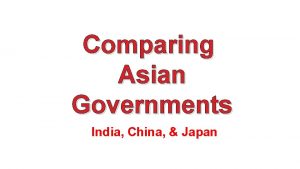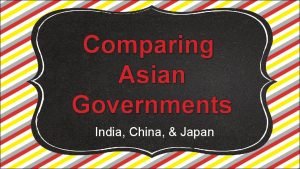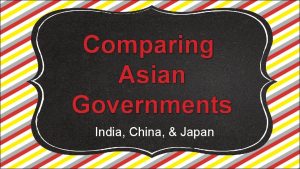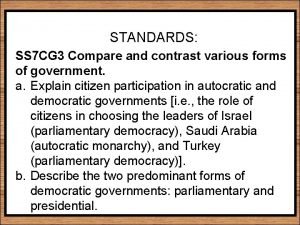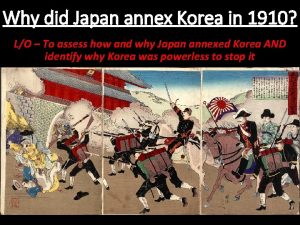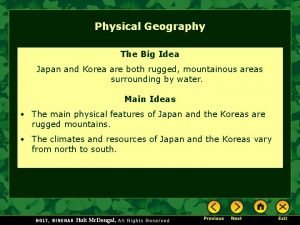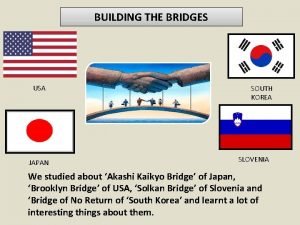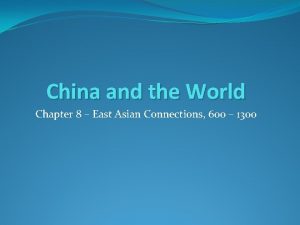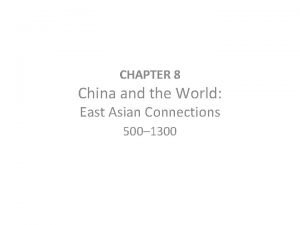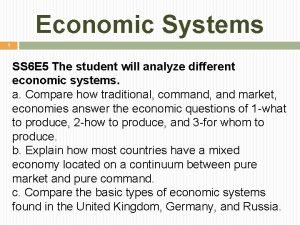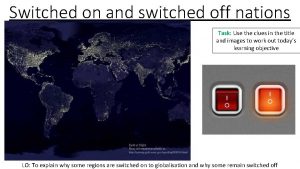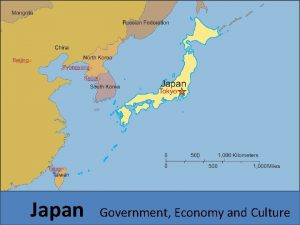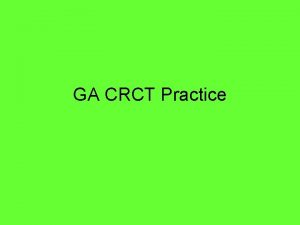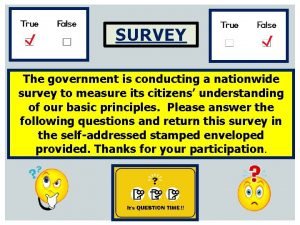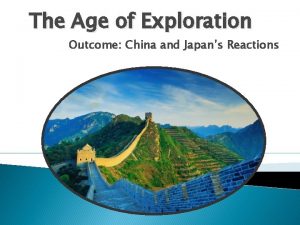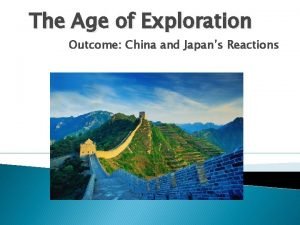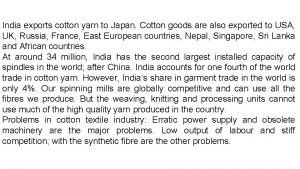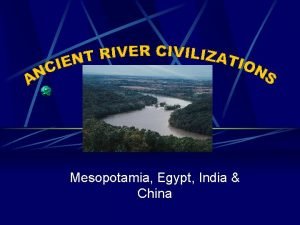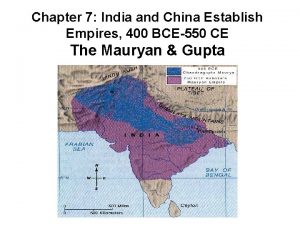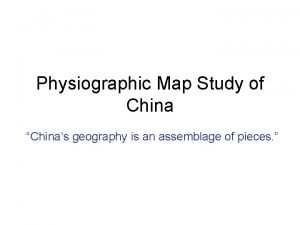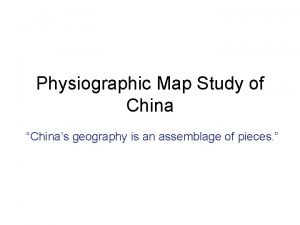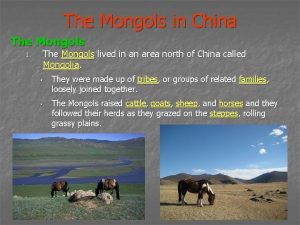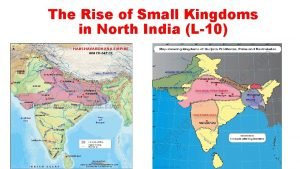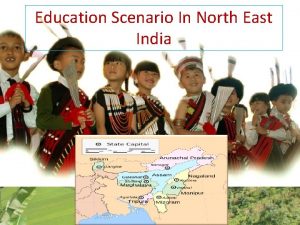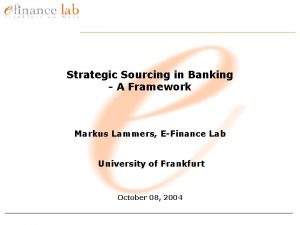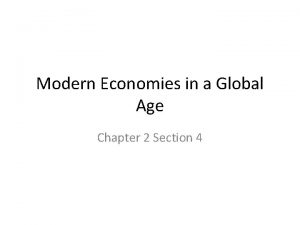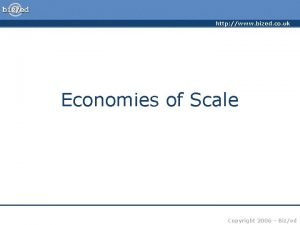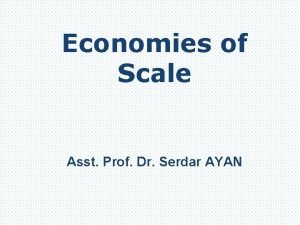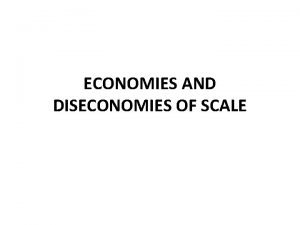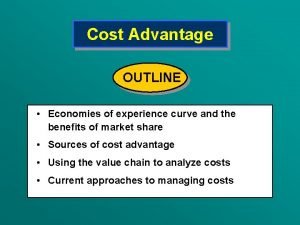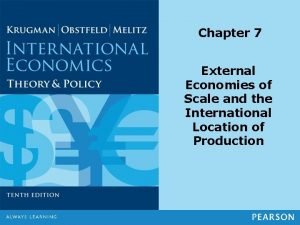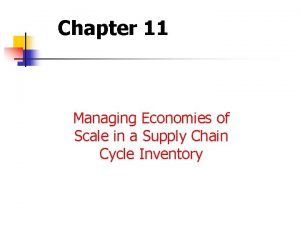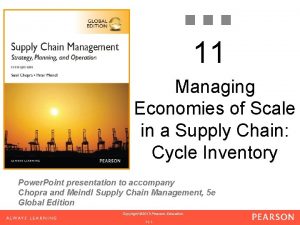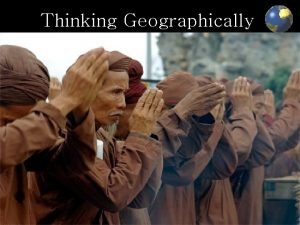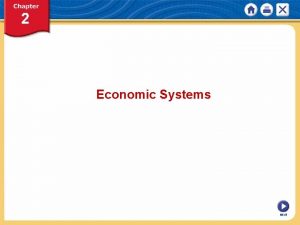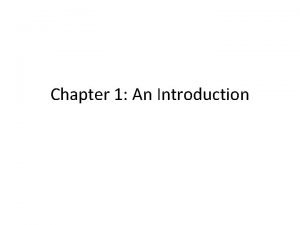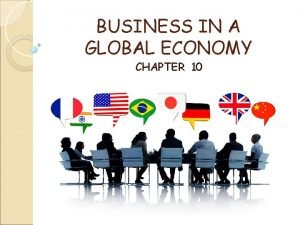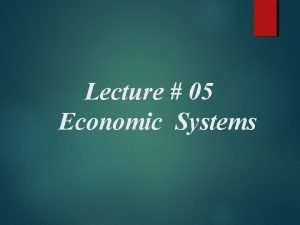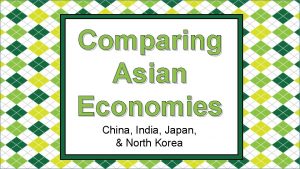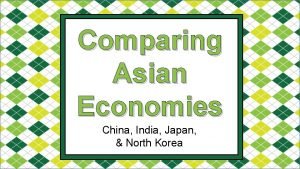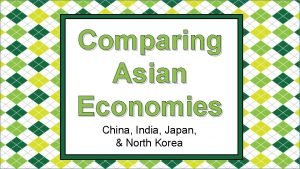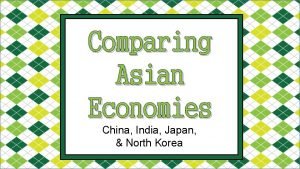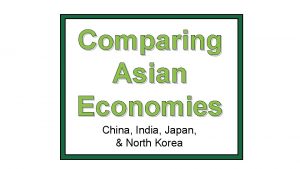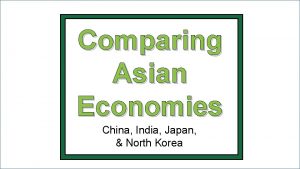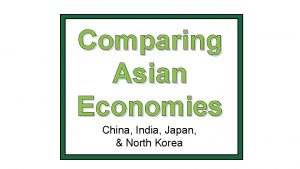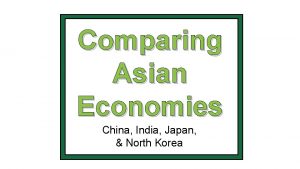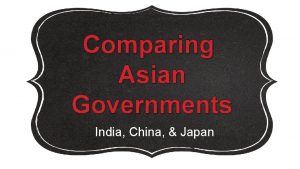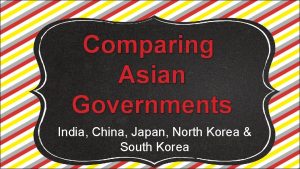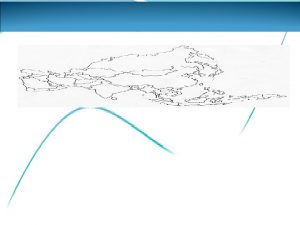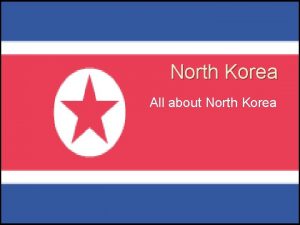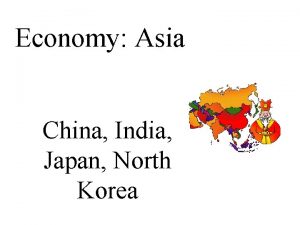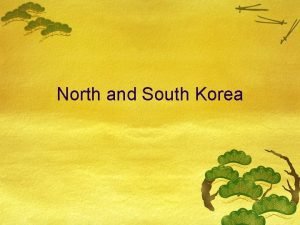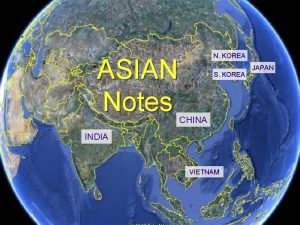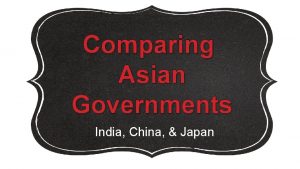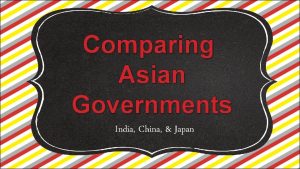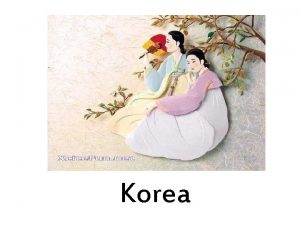Comparing Asian Economies China India Japan North Korea


























































- Slides: 58

Comparing Asian Economies China, India, Japan, & North Korea

China

Economic System • China is transitioning from a command economy that was completely controlled by the Chinese Communist government to a mixed economy that is overseen by the Communist government. • China calls its economy a “socialist market economy”. • During the 1970 s, China’s government began to reorganize the economy with a plan called the Four Modernizations. • These reforms have led to excellent growth in China’s economy. • China is gradually reducing government control and allowing more foreign investment. • Today, China’s economy continues to be growing and strong, and many Chinese enjoy a higher standard of living than ever before.

GDP • China’s GDP is $12. 26 trillion (US dollars). • It is ranked 3 rd in the world (after the US and EU). • China’s GDP goes up about 8% every year. • The GDP per capita (value of goods and services produced person) is $9, 100.

Natural Resources • The massive country of China has an abundance of natural resources. • What are China’s major natural resources? • coal, iron ore, petroleum, natural gas, mercury, tin, tungsten, antimony, manganese, molybdenum, vanadium, magnetite, aluminum, lead, zinc, rare earth elements, uranium, hydropower potential (world's largest) • Even though much of China’s land is not arable (good for farming), the country’s land rivers provide a good foundation for China’s industry and economic growth.

Chinese Coal Miners

Land Use • What percentage of the land is arable (capable of being farmed)? • 11. 6% • China is the world leader in gross agricultural output. • What are the major agricultural products? • rice, wheat, potatoes, corn, peanuts, tea, millet, barley, apples, cotton, oilseed, pork, fish

Longji Rice Terraces, China

Industries • China has made important capital investments that serve as the foundation for its growing GDP. • It has poured lots of money into its manufacturing sector, which accounts for 46% of its GDP. • It is the world leader in gross value of industrial output. • What’s produced in China’s factories? • mining and ore processing, iron, steel, aluminum, and other metals, coal, machine building, armaments, textiles and apparel, petroleum, cement, chemicals, fertilizers, consumer products - including footwear, toys, and electronics, food processing, transportation equipment - including automobiles, rail cars and locomotives, ships, & aircraft, telecommunications equipment, commercial space launch vehicles, satellites

Specialization • China has become a leader in exporting consumer goods to the world market. • China’s chief exports include: • electrical and other machinery, including data processing equipment, apparel, radio telephone handsets, textiles, integrated circuits

Toy Assembly Line in China

Literacy Rate • What percentage of the population over the age of 15 can read and write? • 95% • How long are students expected to stay in school? • Most students drop out of school when they are 12 years old.


Chinese Middle School

Unemployment Rate • What percentage of people do not have jobs? • 6. 5% of China’s workforce is unemployed. • What percentage of people live in poverty? • 13. 4% of China’s population live below the poverty line and cannot meet basic needs.

Entrepreneurship • The Chinese government did not let people start their own businesses until the late 1970 s, so entrepreneurship is still relatively new. • The government realizes that the country has to be more competitive in the world market, so they have decided to let entrepreneurs help lead the way. • Now, private business is the fastest growing segment of China’s economy. • Many Chinese people today have small businesses of their own, even though the government still has final authority.

India

Economic System • After India’s independence in 1947, the government set up a command economy. • Starting in 1991, India began to lift some government control and allow citizens a role in running some of India’s industries. • Today, India has a mixed economy that is moving away from a command system. • India’s government makes some decisions about agriculture and industry, but free enterprise and entrepreneurship are very common.

GDP • India’s GDP is $4. 7 trillion (US dollars). • It is ranked 4 th in the world. • The country’s GDP has been growing at a rate of about 8. 5% per year. • The GDP per capita (value of goods and services produced person) is $3, 800.

Natural Resources • India’s fertile land ample water supply are its most valuable resources. • What are India’s major natural resources? • Coal, iron ore, manganese, mica, bauxite, rare earth elements, titanium ore, chromite, natural gas, diamonds, petroleum, limestone, & arable land • India has the fourth-largest coal reserves in the world.

India’s Coal Mines

Land Use • What percentage of the land is arable (capable of being farmed)? • 47. 9% • About half of India’s land can be farmed, and its most important crops are rice and wheat. • What are the major agricultural products? • rice, wheat, oilseed, cotton, jute, tea, sugarcane, lentils, onions, potatoes, dairy products, sheep, goats, poultry, & fish

Indian Wheat Fields

Industries • India has invested heavily in the factories, modern machinery, and technology that make up what is known as capital goods. • Now, India is one of the world’s top ten industrial nations. • What’s produced in India’s factories? • textiles, chemicals, food processing, steel, transportation equipment, cement, mining, petroleum, machinery, software, & pharmaceuticals • Service industries are also booming in India, with thousands of people employed to handle technology questions, airline reservations, and customer service help for customers around the world.

Textile Factory

Specialization • India has a booming industrial and technological economy. • This specialization makes it possible for India’s economy to focus on the businesses that are the most profitable in the world market. • India’s chief exports include: • petroleum products, precious stones, machinery, iron and steel, chemicals, vehicles, & apparel

Literacy Rate • What percentage of the population over the age of 15 can read and write? • 62. 8% (Male – 75%, Female -- 50%) • How long are students expected to stay in school? • Most students drop out of school when they are 11 years old. • India has made investment in human capital a major priority over the past few decades. • Although India’s literacy rate is low, the rate among children is much higher. • India’s investment in human capital will benefit the economy greatly in the future as educated children enter the workforce.

Middle School Lunch

Unemployment Rate • What percentage of people do not have jobs? • 8. 5% of India’s workforce is unemployed. • What percentage of people live in poverty? • 29. 8% of India’s population live below the poverty line and cannot meet basic needs. • In 2011, India had the largest concentration of people living below the international poverty line of $1. 25 of all Asian countries.

Entrepreneurship • Entrepreneurship is rising dramatically in India. • India has a high rate of entrepreneurship, partly because the government supports new business owners with training and facilities.

Japan

Economic System • • • Japan has one of the most technologically advanced economies in the world. Japan has a mixed economy; the Japanese government has a close and cooperative relationship with major industries in the country. • The government owns few businesses other than the country’s major TV network, but does oversee many aspects of the economy like banking and trade. Japan has few natural resources and little farmland, but it has one of the strongest economies in the world because it built its economy on manufacturing.

GDP • Japan’s GDP is $4. 56 trillion (US dollars). • It is ranked 5 th in the world. • The GDP per capita (value of goods and services produced person) is $35, 900.

Natural Resources • Japan has very little farmland few natural resources. • It imports the raw materials that it needs for industry. • Japan is the world’s largest importer of coal and natural gas, and the second largest importer of oil. • What are Japan’s major natural resources? • Very few mineral resources & fish


Land Use • What percentage of the land is arable (capable of being farmed)? • 11. 3% • Because there is so little arable land, crops are often planted in terraces carved out of hillsides. • What are the major agricultural products? • rice, sugar beets, vegetables, fruit, pork, poultry, dairy products, eggs, & fish • One of Japan’s largest industries is the fishing industry.

Terraced Rice Field

Industries • Investment in capital goods makes Japan a world leader in industrial production and in providing the wide range of services demanded by the world market. • What’s produced in Japan’s factories? • motor vehicles, electronic equipment, machine tools, steel and nonferrous metals, ships, chemicals, textiles, & processed foods • Japan is among the world’s largest and most technologically advanced producers of motor vehicles and electronic equipment. • Industrial production and work in providing services account for almost 98% of Japan’s GDP.

Specialization • Japan is a country with very few natural resources, so specialized industries have been developed to earn money needed to buy food and raw material from other countries. • Japan’s chief exports include: • motor vehicles, semiconductors, iron and steel products, auto parts, plastic materials, & power generating machinery

Nissan Motor Vehicles Plant

Literacy Rate • Japan places a high emphasis on education; the Japanese are among the most highly educated people in the world. • What percentage of the population over the age of 15 can read and write? • 99% • How long are students expected to stay in school? • Most students drop out of school when they are 15 years old.

Japanese Middle School

Unemployment Rate • What percentage of people do not have jobs? • 4. 4% of Japan’s workforce is unemployed. • What percentage of people live in poverty? • 16% of Japan’s population live below the poverty line and cannot meet basic needs.

Entrepreneurship • Japan has one of the lowest rates of entrepreneurship of the world’s top economic powers. • Japanese entrepreneurs face difficulties getting business loans from banks and there is very little training on how to run a business. • Japanese companies typically guarantee lifetime employment, so it is very rare for a person to leave a job to start a new business venture.

North Korea

Economic System • North Korea has one of the least open and most government-controlled economies in the world today. • The Communist party controls the government and the economy, though most of power lies with the dictator, Kim Jong-il. • North Korea has a command economy. • The government controls all the resources and decided what is to be produced. • The North Korean economy has serious problems, and the government is finally making some reforms and relaxing some of its controls.

GDP • North Korea’s GDP is estimated at $40 billion (US dollars). • It is ranked 103 rd in the world. • The GDP per capita (value of goods and services produced person) is $1, 800. • *North Korea does not post reliable income data so these amounts are estimated.

Natural Resources • What are North Korea’s major natural resources? • coal, lead, tungsten, zinc, graphite, magnesite, iron ore, copper, gold, pyrites, salt, fluorspar, & hydropower

Land Use • What percentage of the land is arable (capable of being farmed)? • 19% • Farms are owned and organized by the government: farmers are told what to grow and how much. • What are the major agricultural products? • rice, corn, potatoes, soybeans, cattle, pigs, pork, & eggs • Agriculture in North Korea does not produce enough food to feed its people. • Food aid from other countries has been needed to avoid widespread starvation.

Kim Jong-il Inspecting A Farm

Industries • Premier Kim Jong-il has tried to build up North Korea’s industries in recent years. • The production of steel and machinery are leading industries in the country. • What’s produced in North Korea’s factories? • military products, machine building, electric power, chemicals, mining (coal, iron ore, limestone, magnesite, graphite, copper, zinc, lead, and precious metals), metallurgy, textiles, & food processing

“Farming Simulator – How North Korea Trains Future Farmers”

Factory Inspection

Specialization • North Korea’s chief exports include: • minerals, metallurgical products, manufactures (including armaments), textiles, agricultural & fishery products

Literacy Rate • What percentage of the population over the age of 15 can read and write? • 100%

v North Korea Middle School

Unemployment Rate • What percentage of people do not have jobs? • North Korea’s government does not make this information available. • What percentage of people live in poverty? • North Korea’s government does not make this information available.

Currency Exchange • Currency exchange is the price of one country’s currency compared to another. • • 1 US dollar = 6 Chinese yuan 1 US dollar = 62 Indian Rupee 1 US dollar = 103 Japanese yen 1 US dollar = 131 North Korean won • What does this mean? • China’s economy is the strongest of the Asian countries, but the US’s economy is stronger than China’s.
 Spread of china's literature to heian japan and korea
Spread of china's literature to heian japan and korea Sw asian economies comprehension check answer key
Sw asian economies comprehension check answer key Se asian economies comprehension check answer key
Se asian economies comprehension check answer key Comparing sw asian governments comprehension check
Comparing sw asian governments comprehension check Comparing sw asian governments answer key
Comparing sw asian governments answer key Is japan a unitary state
Is japan a unitary state Comparing asian governments
Comparing asian governments Comparing asian governments
Comparing asian governments Comparing sw asian governments comprehension check
Comparing sw asian governments comprehension check Comparing sw asian governments
Comparing sw asian governments Did japan annex korea
Did japan annex korea Japan physical features
Japan physical features South korea japan bridge
South korea japan bridge Chapter 8 china and the world
Chapter 8 china and the world Chapter 8 china and the world east asian connections
Chapter 8 china and the world east asian connections Asian granito india subsidiaries
Asian granito india subsidiaries Economic spectrum
Economic spectrum Why is north korea switched off from globalisation
Why is north korea switched off from globalisation Japans type of government
Japans type of government North korea genocide 1948-1994
North korea genocide 1948-1994 Which phrase best defines a mountain range?
Which phrase best defines a mountain range? Real life dystopian societies in history
Real life dystopian societies in history North korea unlimited government
North korea unlimited government The age of exploration outcome china and japan's reactions
The age of exploration outcome china and japan's reactions What was the outcome of china's age of exploration?
What was the outcome of china's age of exploration? Ang ideolohiyang isinusulong ni sun-yat sen para sa tsina.
Ang ideolohiyang isinusulong ni sun-yat sen para sa tsina. India export yarn to japan
India export yarn to japan Comparative development experiences of india and china
Comparative development experiences of india and china India china
India china Map of mesopotamia egypt india and china
Map of mesopotamia egypt india and china Organización política de china
Organización política de china Chapter 7 india and china establish empires
Chapter 7 india and china establish empires Ancient india vs ancient china
Ancient india vs ancient china Tci map of china
Tci map of china Physiographic map of china
Physiographic map of china North south china
North south china Where did kublai khan build palaces
Where did kublai khan build palaces The north indian kingdoms
The north indian kingdoms Education in north east india
Education in north east india True north vs magnetic north
True north vs magnetic north Ics north east
Ics north east Lesson quiz 14-1 north and south
Lesson quiz 14-1 north and south The north pole ____ a latitude of 90 degrees north
The north pole ____ a latitude of 90 degrees north Outsourcing defintion
Outsourcing defintion Modern economies in a global age
Modern economies in a global age Benefits of economies of scale
Benefits of economies of scale Serdar ayan
Serdar ayan Types of economies of scale
Types of economies of scale Experience curve economies
Experience curve economies Types of economies of scale
Types of economies of scale Managing economies of scale in a supply chain
Managing economies of scale in a supply chain Economies of scale supply chain
Economies of scale supply chain Economies of scale ap human geography
Economies of scale ap human geography Mixed economies in a sentence
Mixed economies in a sentence Chapter 2 lesson 2 mixed economies
Chapter 2 lesson 2 mixed economies Economies of scale ap human geography
Economies of scale ap human geography The interconnected economies of the nations of the world
The interconnected economies of the nations of the world Sw asia economies cloze notes 1
Sw asia economies cloze notes 1 Characteristics of mixed economies
Characteristics of mixed economies
